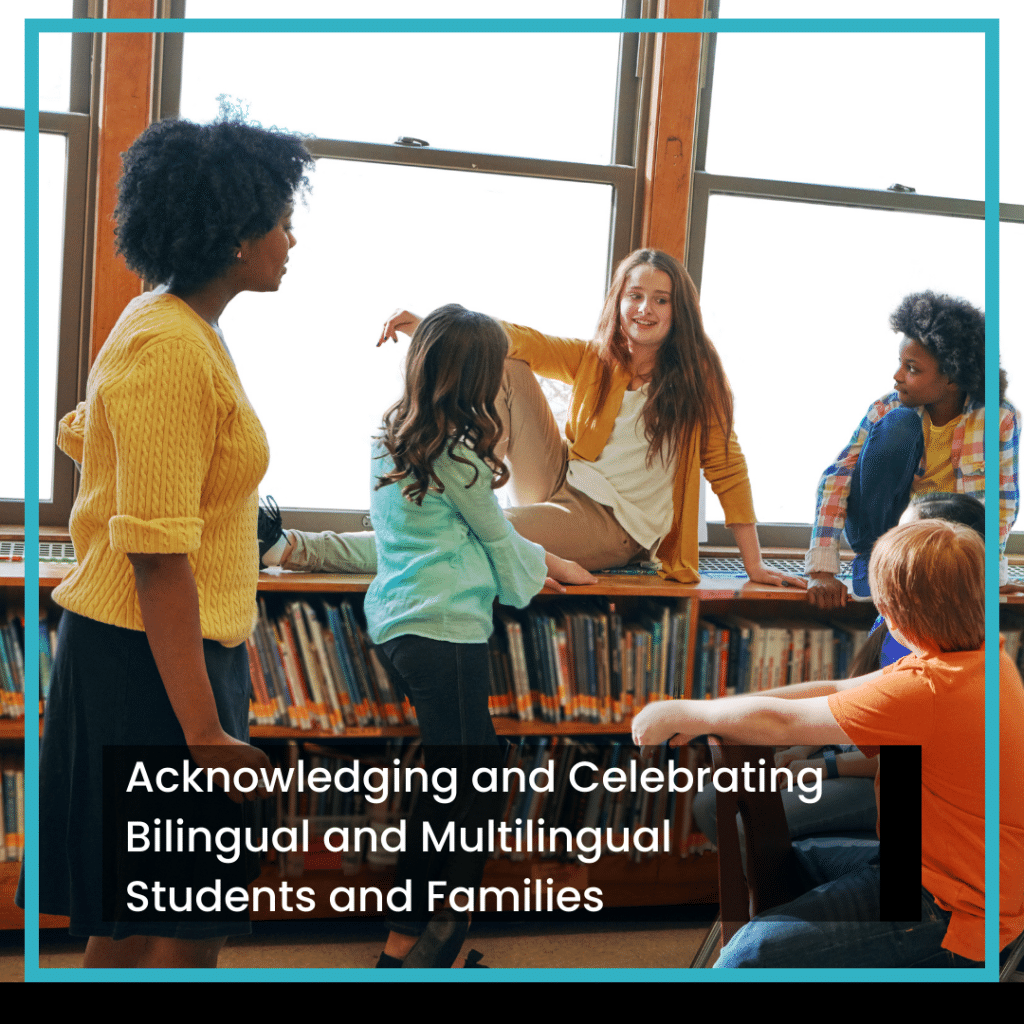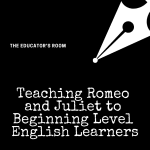April is over. However, we acknowledge, celebrate, and honor multilingual and bilingual students and families continues. As we come to the end of another month, some might see it as a couple of months closer to summer break, others as another month closer to the holidays, but some see it as an opportunity to embrace new experiences and new-found knowledge.
What is National Bilingual and Multilingual Month?
The Office of English Language Acquisition (OELA) recognizes April as National Bilingual and Multilingual Learner Advocacy Month. There is a need for educators to acknowledge, celebrate and honor our students and their achievements, as well as the diversity they bring to our classroom and school. As we acknowledge, celebrate, and honor them, we need to lean into their past and history as well as advocate for their present and future. We need to keep in mind that we have a big task at hand, and we are their voice. We need to provide all of the necessary resources and means for them to have a successful education and a brighter future.
If you are unfamiliar with what bilingual and multilingual really means, if you gasped, side-eyed, or quickly logged onto a new tab on your web browser and asked “your best friend” Google, you and I were on the same page.
Recently, I wrote a piece on Honoring Mother Tongue, and with that came deep discussions as to what we can do to change our frame of thought or how we see things. In one of those conversations, I was asked what I thought about the fact that April is National Bilingual/Multilingual Learner advocacy month, and I was very honest, I had no clue.
I started reading up on it and found many articles from great writers that shared their points of view with us and explained what this month is all about. I identified with many and understood that even though I was not aware that this month was for this in particular, there are points covered that I recognize must be put into place year-round. We don’t only love on Valentine’s Day, do we? We are to honor and love every day and find ways that we can honor each other every day, and for our bilingual and multilingual students, April is the month. Did you honor all of your students in April?
Reflection
Personally, I asked myself, as an educator, what am I doing in my schools to advocate and teach the tools I use in my classroom to fellow educators? As an English Language Learner (ELL) student myself, I felt the challenges and the loneliness as I transitioned into learning a new language and struggled. Not once was it made easy by any of my teachers, students, or school. I don’t blame them for my struggles, I blame it on the broken system.
Back then, there was nothing for them to rely on, no clarity on the resources they could have used, and no knowledge of what an ELL student really needed. I can tell you it was definitely not just a worksheet or letter tracing printout. It went beyond that, and it still does. Today, we are gifted with technology all around us. We are blessed to be able to type something in or, in some cases, just think about it, and it is in our Google suggestions and our social media suggestions and readily available for us to read and reflect on.
ELL students, for many, are labeled as foreign students who come to classrooms in the United States and learn a second language. It seems simple but is not.
Who are our students?
Consider this story I shared with a colleague.
Shantae* was an ELL student of mine whose primary language is Creole. She was born in St. Louis, Missouri raised by her uncle in a demographic population of 44% African American and a high poverty rate. Shantae maintained an A in my class yet struggled in other classroom settings. Colleagues met to set accommodations for Shantae, and I explained that one of the reasons behind the lack of English content acquisition is not because of Shantae’s “laziness”; it is because of her deficiency in the English language.
Shantae speaks Creole making her a bilingual student, but she also has another gap in her learning. The language spoken at home was not English; it was slang. To some, slang may not be identified as a language, but according to Oxford Academic, “ suggests that if a means of communication is a language, then slang is surely a part of the overarching English language as much as any other lexical subset such as jargon, technicalities, and regionalisms.”
Shantae was in a 6th-grade classroom with a second-grade level of English and Reading comprehension. We came to a consensus that Shantae* falls under the realm of a bilingual/multilingual student, and accommodations in all of her classrooms needed to be revisited in order for us to help her succeed. We created techniques that transitioned effortlessly from one class to another. They cohesively formed a part of her daily routine, and she demonstrated growth as an ELL student who was on a path to exit those accommodations and began reaching her goals. Not only were we able to help her academically, but colleagues were able to build relationships and assisted in Shatae stepping out of her comfort zone.
What is my philosophy behind the work?
My philosophy is that every student is like the fingers in your hand. Do they all look alike? Are they the same length? Rarely! Our bilingual and multilingual students bring so many gifts that we are literally unwrapping them one layer at a time. They have individual needs, and it is our duty to advocate for them and fulfill those needs.
Advocating for communities
Language is a big process of our journey in education, whatever position we hold. My position as an educator currently teaching Medical Science, Teach Plus Nevada fellow, and advocator allows me the privilege to bring forward the needs in my classroom and in our school as well as share recommendations that may be helpful to others. Recently, I was gifted the opportunity to travel to Carson City, Nevada, and sat on the legislative floor with another educator, Assemblywoman Selena La Rue Hatch, and we shared ideas on implementing all of the necessary tools for all children to succeed not only in their younger years but in their future careers. Students told us they need that acquisition to move ahead. While from an educator’s perspective, there are many things they told us, as well as from the school administrators, staff, leaders, and so on.
During the process of my reflection, I asked myself if I am the right person for this.
Why do I have this desire in my heart to not only explain the multicultural and linguistic challenges but also to honor our multicultural families if I am one of them? I feel undeserving of this privilege. But as I sit back and reflect on who I am really doing this for, the answer is always the same, my students.
Then, how do I make a difference? What are the resources that can help me continue to advocate for students who are bilingual, multilingual, and multicultural and are facing so many challenges?
What strategies help our multilingual and bilingual students?
Connect with students.
Through my experiences of growing up in Miami, Florida, I was able to embrace many different cultures, as well as accents, foods, and traditions. Now as an educator with the growth in diversity in my state, and especially in the city of Las Vegas, I am able to use those experiences not only as a connection with my students but as the comfort of someone that cares and is familiar with their struggles. I am able to connect what I learned not limited to the languages but also to the foods, traditions, and challenges one might have faced in their country.
Sometimes, my Cuban accent comes out, and it breaks the ice in a room where my incoming student Jose* from Cuba, is now enrolled. He becomes enlightened by the accent and steps out of his comfort zone. My students say they admire how many languages I speak when in reality, I don’t fully speak, comprehend or understand multiple languages. However, I have picked up a little bit of many here and there, such as Creole, French, Italian, Spanish, and my favorite, Pig Latin.
Create a safe learning space.
I aspire every day for my room to be a place where students feel safe, connected, and understood. It is not limited to the students on my roster. There is a student who, to many,are known as “the troublemaker.” My hope is that we place our efforts and focus on choosing better references for our students. They are our future! She had never spoken to me, but I always greeted her with a good morning or “Hola.”
The other day, with about 24 days left of school year, she says “Hola señora” and I say, “Señora no por favor, me siento muy viejita”, she smiles. I then see her the following day, and she greets me with, “Hola Señorita,” and I reply, “Hola Bella.” Since then, she has not missed a day to greet me and come into my room. Acknowledge that we need safe areas in our classrooms, in our schools, and in our districts for our students, families, and communities. In our district, they recently opened the CCSD Family Support Center, which focused on family education and engagement by providing valuable resources and learning opportunities.
Celebrate and honor our students.
I recently created a couple of certificates for my ELL students. These certificates include but are not limited to a Certificate of Proficiency, Certificate of Completion, Certificate of Achievement, and more. These certificates resemble a milestone achievement for them. They are proud of moving forward in their education. We are honoring their short goals in an effort that they feel celebrated often and setting a path for a positive future and long-term goal achievement.
Build a community.
There are no limits to communication with your families and communities. Using a communication tool called Remind, I am able to communicate with and build relationships with my family in their preferred language. I have families that are bilingual/multilingual, and with this platform, we are able to stay connected very often, and I don’t mind it one bit.
These connections can not be missed. Break the cycle, break the labels, break the molds that all students are from the same mold. Be the change! My friend Sean Hirten said it best, “I have really been putting time in to learning more and more Spanish. It is starting to pay off, and I have reached a new level. But I am still very much a Gringo who knows nothing! It opens up so many doors for me in terms of connecting with students and being able to communicate with parents better.”
This is what we have to do, step out of our comfort zone and embrace all that is around us. At the end of the day, a classroom is not only to teach our students; it is to learn from them as well.
Karen Villatoro Gonzalez is a 2022-23 Teach Plus Policy Fellow. Karen is currently in her third year of teaching with the Clark County School district. Karen is currently a Medical Magnet educator and has taught English and ELL learners.







